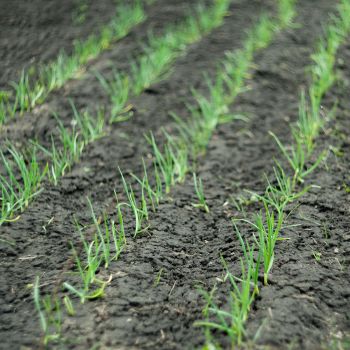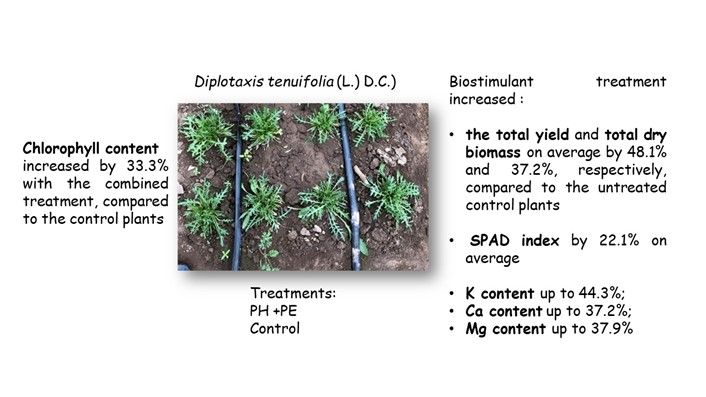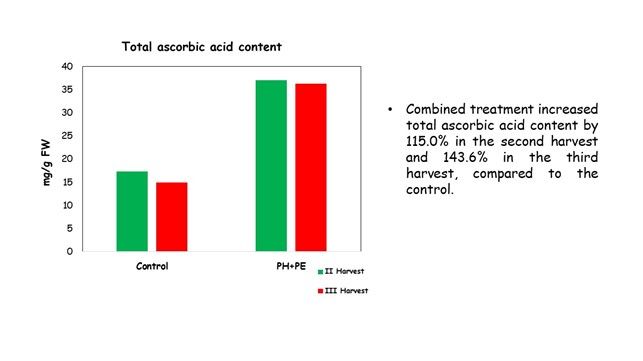Synergistic interactions among biostimulants and effects on productivity and quality of crops
By: Maria Giordano
Department of Agricultural Sciences, University of Naples Federico II, 80055 Portici, Italy
*Correspondence: maria.giordano@unina.it

Plant biostimulants are substances and microorganisms, such as humic acids, protein hydrolysates, algae extracts, mycorrhizal fungi, and plant growth-promoting rhizobacteria (Azospirillum, Azotobacter, Rhizobium spp.). Most of the experiments with biostimulants, carried out to date, are aimed at understanding the effectiveness of a single biostimulant on plants and/or the effect of different doses of each biostimulant. These experiments highlighted the role of biostimulants in stimulating nutrients uptake, increasing tolerance abiotic stresses, and the performance of crops in terms of production and quality. Metabolomics, genomics, transcriptomics, and phenotyping technologies are highly contributing to identifying the physiological mechanisms behind these responses. Understanding the interactions that can be established among different categories of biostimulants will be an important milestone. This knowledge would allow the development of new formulations of biostimulants that will represent the second generation of biostimulants (or biostimulant 2.0), able to respond efficiently and specifically to different agronomic needs. It would also allow a reduction in the use of chemical fertilizers and would make agriculture more sustainable.
Two or more biostimulants used together can create additive, synergistic, or antagonistic interactions. In an antagonistic interaction, the conclusive effect is less than the one occurring when the biostimulants are used individually. In the additive interaction, each biostimulant keeps the same action as when used alone, and therefore each one of them adds its own action to the overall effect of the mixture. In the synergistic interaction, the overall effect of the mixture is greater than the sum of the effects of each biostimulant applied individually.
Synergistic or additive effects of microbial and non-microbial biostimulants on the growth and production of some crops have been summarized by Rouphael and Colla, 2018.
For instance, biostimulants consisting of algae extracts (SWE) and humic acids (HA) increased the height and branching of groundnut plants compared to untreated plants (if using HA, by 34.5% and 33%, respectively, if using SWE, by 17.2 and 60.0%, respectively). The combination of the two biostimulants however increased the two parameters to a greater extent concerning not only the untreated plants, but also the sum of the effects of each biostimulant. The two parameters increased by 65.0% and 100% respectively, demonstrating a synergistic effect of the two biostimulants.
In another study, dry weight of onion roots and carotenoid content increased by 43.9% and 12.1% respectively if humic acids (HA) were added one day after transplanting seedlings, compared to untreated plants. The application of liquid mycorrhizal inoculum (Rhizophagus intraradices) in the rhizosphere increased the two parameters respectively by 29.6% and 57.1%. A synergistic effect was shown when the two biostimulants (HA and mycorrhizal inoculum) were combined, since the increase in the dry weight of the roots and the carotenoid content, compared to untreated plants, was 106.7 and 123.6%. The combination of mycorrhizal fungi (Rhizophagus intraradices) and HA spray application to the perennial ryegrass substrate resulted in a greater increase of root biomass and chlorophyll content than when each biostimulant was used alone.
A synergistic effect was reported when roots of pineapple plantlets were immersed for 24 hours in a suspension of vermicompost derived-HA, followed by application of HA to the basal leaf axils of plants at 14-day intervals and dipping of the roots before planting in a plant growth promoting bacteria cell suspension for 30 min. Plants increased the shoot dry weight and the leaf area when the two biostimulants were applied alone and, when they were combined, they increased them more than the sum of the single effects.
Synergistic action of endophytic fungal consortium (R. irregulare BEG72 and Trichoderma atroviride MUCL45632) combined with a plant-derived PH, was also demonstrated. This combination increased crop productivity through an increase in chlorophyll biosynthesis, higher activity of the PSII, and greater absorption of nutrients in lettuce crop.
Considering the results of the works mentioned above, farmers may find it convenient to combine different types of biostimlants. Giordano and collaborators (2020) assessed the effect of two different plant-based biostimulants: legume-derived protein hydrolysates (PH) and tropical plant extract (PE). These are made of different percentage of free amino acids, peptides, carbohydrates, and mineral nutrients. Tropical plant extract also contains vitamins and phytohormones. Furthermore, on the one hand, PH was found to increase photosynthethic activity and nitrogen metabolism in several horticultural crops, on the other hand PE had a hormone-like activity and incresead the tolerance of plants to different environmental stresses. PH and PE were used in combination, on the growth and nutritive qualities of perennial wall rocket (Diplotaxis tenuifolia (L.) D.C.), grown in a greenhouse. The biostimulant treatments were weekly applied as foliar spray, starting when leaves reached 6 cm in length, to facilitate the absorption of the biostimulant susbtances. PH + PE were administered at a dose of 2.0 + 0.5 mL per liter, respectively (Figure 1).

Figure 1.
Total ascorbic acid in rocket leaves significantly increased in the combined treatment, compared to the control (Figure 2).

Figure 2.
The presumed mechanisms behind the premium quality wall rocket trait (high total ascorbic acid content), could be due to the activity stimulation of key enzymes involved in antioxidant homeostasis in cells (direct mode of action). An increase in ascorbic acid content was linked to the overexpression of the L-galactono-1,4-lactone dehydrogenase enzyme (L-GalLDH) in lettuce plants. This enzyme has an N-terminal target sequence rich in Ala, Leu, Arg, and Ser and to a lesser extent Asp, Glu, Ile, and Val. In the present work, the two biostimulants combination probably increased the amount of amino acids, which led to an overexpression of L-GalDH.
The combination of PH and PE may represent a promising tool for increasing the nutritive value of perennial wall rocket.
Giordano, M., El-Nakhel, C., Caruso, G., Cozzolino, E., De Pascale, S., Kyriacou, M.C., Colla, G., Rouphael, Y. Stand-alone and combinatorial effects of plant-based biostimulants on the production and leaf quality of perennial wall rocket. Plants 2020, 9, 922. doi:10.3390/plants9070922
Rouphael, Y., Colla G. Synergistic biostimulatory action: designing the next generation of plant biostimulants for sustainable agriculture. Frontiers in Plant Science 2018, 9, 1655. doi:10.3389/fpls.2018.01655



